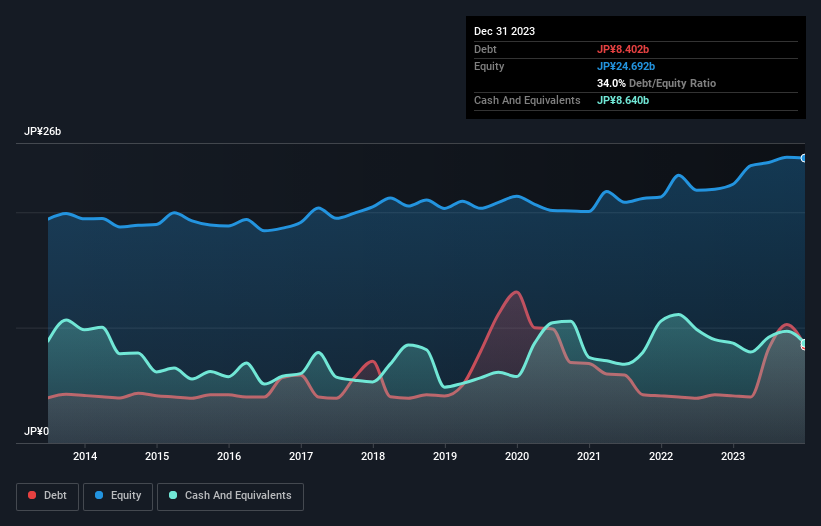
Warren Buffett famously said, 'Volatility is far from synonymous with risk.' So it might be obvious that you need to consider debt, when you think about how risky any given stock is, because too much debt can sink a company. As with many other companies Chugai Ro Co., Ltd. (TSE:1964) makes use of debt. But is this debt a concern to shareholders?
Why Does Debt Bring Risk?
Debt is a tool to help businesses grow, but if a business is incapable of paying off its lenders, then it exists at their mercy. If things get really bad, the lenders can take control of the business. However, a more common (but still painful) scenario is that it has to raise new equity capital at a low price, thus permanently diluting shareholders. By replacing dilution, though, debt can be an extremely good tool for businesses that need capital to invest in growth at high rates of return. When we think about a company's use of debt, we first look at cash and debt together.
Check out our latest analysis for Chugai Ro
How Much Debt Does Chugai Ro Carry?
As you can see below, at the end of December 2023, Chugai Ro had JP¥8.40b of debt, up from JP¥4.08b a year ago. Click the image for more detail. But it also has JP¥8.64b in cash to offset that, meaning it has JP¥238.0m net cash.

How Strong Is Chugai Ro's Balance Sheet?
According to the last reported balance sheet, Chugai Ro had liabilities of JP¥18.8b due within 12 months, and liabilities of JP¥2.91b due beyond 12 months. Offsetting this, it had JP¥8.64b in cash and JP¥22.7b in receivables that were due within 12 months. So it actually has JP¥9.64b more liquid assets than total liabilities.
This surplus liquidity suggests that Chugai Ro's balance sheet could take a hit just as well as Homer Simpson's head can take a punch. Having regard to this fact, we think its balance sheet is as strong as an ox. Succinctly put, Chugai Ro boasts net cash, so it's fair to say it does not have a heavy debt load!
In addition to that, we're happy to report that Chugai Ro has boosted its EBIT by 50%, thus reducing the spectre of future debt repayments. There's no doubt that we learn most about debt from the balance sheet. But it is Chugai Ro's earnings that will influence how the balance sheet holds up in the future. So when considering debt, it's definitely worth looking at the earnings trend. Click here for an interactive snapshot.
But our final consideration is also important, because a company cannot pay debt with paper profits; it needs cold hard cash. While Chugai Ro has net cash on its balance sheet, it's still worth taking a look at its ability to convert earnings before interest and tax (EBIT) to free cash flow, to help us understand how quickly it is building (or eroding) that cash balance. During the last three years, Chugai Ro burned a lot of cash. While investors are no doubt expecting a reversal of that situation in due course, it clearly does mean its use of debt is more risky.
Summing Up
While we empathize with investors who find debt concerning, you should keep in mind that Chugai Ro has net cash of JP¥238.0m, as well as more liquid assets than liabilities. And it impressed us with its EBIT growth of 50% over the last year. So we don't think Chugai Ro's use of debt is risky. There's no doubt that we learn most about debt from the balance sheet. But ultimately, every company can contain risks that exist outside of the balance sheet. We've identified 3 warning signs with Chugai Ro , and understanding them should be part of your investment process.
If you're interested in investing in businesses that can grow profits without the burden of debt, then check out this free list of growing businesses that have net cash on the balance sheet.
New: AI Stock Screener & Alerts
Our new AI Stock Screener scans the market every day to uncover opportunities.
• Dividend Powerhouses (3%+ Yield)
• Undervalued Small Caps with Insider Buying
• High growth Tech and AI Companies
Or build your own from over 50 metrics.
Have feedback on this article? Concerned about the content? Get in touch with us directly. Alternatively, email editorial-team (at) simplywallst.com.
This article by Simply Wall St is general in nature. We provide commentary based on historical data and analyst forecasts only using an unbiased methodology and our articles are not intended to be financial advice. It does not constitute a recommendation to buy or sell any stock, and does not take account of your objectives, or your financial situation. We aim to bring you long-term focused analysis driven by fundamental data. Note that our analysis may not factor in the latest price-sensitive company announcements or qualitative material. Simply Wall St has no position in any stocks mentioned.
About TSE:1964
Chugai Ro
Engages in the development of technologies in the thermal technology field in Japan and internationally.
Excellent balance sheet average dividend payer.
Market Insights
Community Narratives




